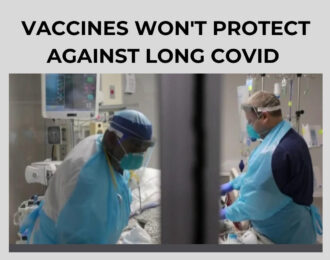To help people with long COVID, scientists need to define it

WIRED – November 2021
Author: WIRED Staff
Almost from the beginning of the COVID pandemic, reports have accumulated of persistent, weird, disabling symptoms in survivors, a syndrome that’s come to be known as long COVID. The complex of fatigue, confusion, heart arrhythmias, gut disorders, and other problems—which may persist months after an infection begins or arise months after it seems to have concluded—has attracted attention and sympathy, intense patient activism, substantial research interest, and huge government investment. Last December, the US Congress voted in $1.15 billion to fund four years of research into long COVID, and this February, the US National Institutes of Health announced it would use those funds to create a nested set of large studies examining adult and child experiences of the syndrome.
What makes long COVID research urgent is also what makes it, at this point, so challenging. No one has yet been able to determine its cause, beyond the association that it occurs in people who have had COVID—or who think they did but weren’t able to get a test to prove it. This makes it difficult to understand and therefore to predict who is vulnerable: why one patient develops lasting symptoms and another does not.
A new study of long COVID patients in France, published in November in JAMA Internal Medicine and done by researchers at several universities and medical centers in France and Italy, is complicating that problem. The researchers surveyed 26,283 patients about the patients’ experiences with COVID and any long-lasting symptoms, and they also analyzed samples of patients blood for antibodies that would confirm the infections. Their findings: the thing that most predicted whether patients developed long COVID symptoms was whether they believed they had been infected, not whether their infection could be lab-confirmed.
“Further research in this area should consider underlying mechanisms that may not be specific to the SARS-CoV-2 virus,” the authors wrote. “A medical evaluation of these patients may be needed to prevent symptoms due to another disease being erroneously attributed to ‘long COVID.'”
This study hasn’t upended research into long COVID: the field is too new for that. But for scientists working on the problem, it emphasizes the difficulty of carving out a research agenda for a syndrome so new, multifarious, and widespread. And it raises the unsettling prospect of having to broach to patients, without being dismissive, that the symptoms they are experiencing may not be caused by COVID at all.
There is a long history of new diseases being brought to medical attention by patients—often by women, who between monthly menstruation and routine GYN visits tend to be more in tune with their bodies than men are—and then dismissed by medicine as imagined. Lyme disease is one such example; myalgic encephalomyelitis/chronic fatigue syndrome, another. Researchers are determined that long COVID not go down that road.
“As a physician, but also as a woman, I have seen so many of these poorly defined syndromes get dismissed, and seen patients have no alternative other than quackery, when there really is a pathophysiologic basis for their symptoms,” says Megan Ranney, a physician and associate dean at the Brown School of Public Health and co-director of a new long COVID initiative there. “As an emergency physician, I have seen, firsthand, patients with persistent symptoms after COVID infection that have dramatically shifted their life. They deserve us to bring scientific rigor to the question—and for folks for whom some of these symptoms may exist and may not be due to COVID, they deserve some sort of an explanation and treatment as well.”
There are so many challenges inherent in carving out a long COVID research agenda, starting with the most basic: no one can say at this point how many people suffer from it. Here are the results of just a few studies: one conservative estimate in the United Kingdom, based on a survey conducted by Kings College London, landed on 2.3 percent of patients experiencing symptoms 12 weeks beyond their initial illness—while a study by Imperial College London put the proportion, at the same time period, at 37.7 percent.
In China, 26 percent of a cohort of patients who were hospitalized for COVID had difficulty sleeping six months after their symptoms began, and 63 percent had ongoing muscle weakness. In the US, several estimates land at more than a third of COVID patients, from 35 percent not returning to their usual state of health after three weeks, to 36.5 percent after six months. And a systematic review of 57 studies done worldwide, completed in October, found that half of people who had COVID symptoms were still experiencing health problems six months later.
Those wide ranges are likely due in part to who was asked. Depending on the survey, it might be people who had received positive test results, or were hospitalized, or spent time in an ICU—or, in some patient-group data sets, people who could not access tests while they were ill. But it is also almost certainly due to the reality that there is neither a test nor a universal case definition for long COVID, no agreed-upon single checklist of symptoms and measurable vital signs. In fact, one study that helped set the agenda for discussing long COVID, published last December by British and American academic researchers and a consortium of patients, lists more than 200 symptoms affecting entire body systems.
SARS-CoV-2 is a respiratory virus, but many of those symptoms reach far beyond the lungs, affecting muscles and joints, the heart and circulatory system, the gut, and the nervous system and brain, including long COVID’s notorious “brain fog.” To complicate the picture further: while some patients continue to experience, for months, the same symptoms they had when they first fell ill, others develop problems in different parts of their bodies—and some don’t develop their long-lasting symptoms until weeks or months after their illness seems to have resolved.
This gets yet more complex once you consider that long duration of symptoms after an infection is not unique to COVID. Patients recovering from bacterial pneumonia experience months of fatigue and shortness of breath. Influenza can damage heart muscle. The inflammation generated by severe foodborne illness has been linked to high blood pressure and kidney problems years later. And “post-intensive care syndrome”—long-lasting muscular weakness, cognitive problems, even PTSD—is a recognized consequence of an ICU stay.
Those known effects suggest that researchers will have to ask: is long COVID simply the expression of such post-infection symptoms, made visible because there has never before been one infection shared in a short period of time by so much of the world? Or is long COVID evidence of damage that is only caused by SARS-CoV-2?
“I think SARS-CoV-2 is a unique virus that causes effects on the body that are different from other sorts of viruses,” says Leora Horwitz, an internal medicine physician and professor at NYU Grossman School of Medicine and one of the principal investigators of the clinical science core in the NIH-funded Recover studies. “Early on, people said: ‘Oh, it’s just like the flu.’ It’s nothing like the flu. Flu doesn’t cause blood clots, doesn’t cause kidney failure, doesn’t cause all the things that we demonstrably know SARS-CoV-2 causes.”
But the things that SARS-CoV-2 does cause are multifarious, and that raises the possibility that long COVID might not be a single syndrome; it might instead be multiple syndromes for which the only commonality is the initial infection. “Some people are having prolonged respiratory symptoms, shortness of breath, cough; some people are having myocarditis and other cardiac symptoms; some people are having blood clots that are causing strokes,” Horwitz says. “Some people are having neuropathic-type symptoms, or confusion, or brain fog, or dizziness or lightheadedness; some people are having depression and anxiety. Those are likely going to turn out to be different phenotypes, different types of long COVID.”
Just statistically, sorting out the questions to ask about long COVID is a challenge like no other. Comparisons will be difficult: patients were infected at different times in the pandemic, when different variants were circulating. Treatment approaches have evolved, and in the early days confirmatory tests may have been hard to access. It will also be challenging to sort out what epidemiologists call confounders, variables that influence any factors being analyzed. In a population as large as the potentially millions of people with long COVID, other previously undiagnosed diseases would be expected to occur. Cancer, heart disease, autoimmune conditions, depression—all of those could cause some of the symptoms for which long COVID is blamed.
At the population level, that confusion will make the occurrence and types of long COVID more difficult to untangle. At the individual patient level, it could be catastrophic. Jeremy Faust, an emergency physician at Boston’s Brigham and Women’s Hospital who analyzed the French long COVID study in his newsletter Inside Medicine, worries about what he calls “premature diagnostic closure”—assigning symptoms to an explanation that feels logical but might not be right. “The last thing we want,” he says, “is to have you chalk your fatigue and brain fog up to long COVID when, in fact, you need a CAT scan of your head to make sure you don’t have a tumor.”
There’s one other possible confounder, gently hinted at in the French study, that disturbs researchers seeking to define long COVID. That is the profound influence of the trauma of the pandemic as it approaches the end of its second year. Just as there has never been an epidemic of this magnitude in our lifetimes, there has never been such a prolonged shared experience of overwhelming suffering: deaths, job losses, relocations and evictions, political division.
One challenge of defining long COVID is persuading patients that trauma may be playing a role in their symptoms—without appearing to tell them that it is all in their heads. Researchers are at pains to affirm to patients that while they are authentically ill, the cause of their illness may not be what they believe it to be.
This is hard. Diagnoses are validating; they put a frame of meaning around the chaos of illness. A diagnosis of long COVID in particular might give someone bewildered by strange symptoms a sense of purpose, a chance to identify with the patients’ collaboratives who are sharing information and reassurance as a means of turning their suffering to good. Scientists wrestling with definitions for the syndrome worry about taking that emotional support away.
“The entire conversation about whether or not long COVID is real is predicated on this assumption that something physiologic is real, and something psychiatric is not real,” says Daniela J. Lamas, a critical care physician and assistant professor at Harvard Medical School who co-directs the COVID Recovery Center at Brigham & Women’s Hospital. “And that’s not accurate. There’s a tremendous amount of suffering in these patients.”
Scientists need to narrow the definition of long COVID in order to be able to research it—and conflating the physical impact of the virus with the aftereffects of trauma could slow the search for remedies. But at the same time, acknowledging that some portion of the syndrome may arise not from a single infection but from shared grief could allow us to reframe, and name, the greater harms the pandemic has wrought.
“Very few illnesses have just one cause, and chronic illness in particular has many causes,” says Adam Gaffney, a physician, author, and assistant professor at Harvard Medical School. “We need to move away from a hierarchy of suffering that gives greater validation to certain types of suffering than others. You shouldn’t need an MRI finding or lab tests to have your experience of illness validated.”





